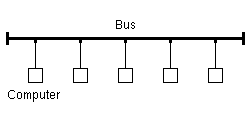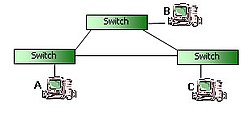Ethernet
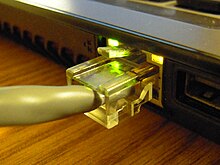

Ethernet(/ˈiːθərnɛt/EE-thər-net) is a family of wiredcomputer networkingtechnologies commonly used inlocal area networks(LAN),metropolitan area networks(MAN) andwide area networks(WAN).[1]It was commercially introduced in 1980 and first standardized in 1983 asIEEE 802.3.Ethernet has since been refined to support higherbit rates,a greater number of nodes, and longer link distances, but retains muchbackward compatibility.Over time, Ethernet has largely replaced competing wired LAN technologies such asToken Ring,FDDIandARCNET.
The original10BASE5Ethernet uses a thickcoaxial cableas ashared medium.This was largely superseded by10BASE2,which used a thinner and more flexible cable that was both cheaper and easier to use. More modern Ethernet variants usetwisted pairandfiber opticlinks in conjunction withswitches.Over the course of its history, Ethernet data transfer rates have been increased from the original2.94Mbit/s[2]to the latest400 Gbit/s,with rates up to1.6Tbit/sunder development. TheEthernet standardsinclude severalwiring and signaling variantsof theOSI physical layer.
Systems communicating over Ethernet divide a stream of data into shorter pieces calledframes.Each frame contains source and destination addresses, anderror-checking dataso that damaged frames can be detected and discarded; most often, higher-layer protocols triggerretransmissionof lost frames. Per theOSI model,Ethernet provides services up to and including thedata link layer.[3]The 48-bitMAC addresswas adopted by otherIEEE 802networking standards, includingIEEE 802.11(Wi-Fi), as well as byFDDI.EtherTypevalues are also used inSubnetwork Access Protocol(SNAP) headers.
Ethernet is widely used in homes and industry, and interworks well with wirelessWi-Fitechnologies. TheInternet Protocolis commonly carried over Ethernet and so it is considered one of the key technologies that make up theInternet.
History[edit]
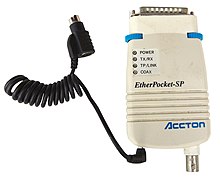
Ethernet was developed atXerox PARCbetween 1973 and 1974[4][5]as a means to allowAlto computersto communicate with each other.[6]It was inspired byALOHAnet,whichRobert Metcalfehad studied as part of hisPhDdissertation[7][8]and was originally called the Alto Aloha Network.[6]Metcalfe's idea was essentially to limit the Aloha-like signals inside a cable, instead of broadcasting into the air. The idea was first documented in a memo that Metcalfe wrote on May 22, 1973, where he named it after theluminiferous aetheronce postulated to exist as an "omnipresent, completely passive medium for the propagation of electromagnetic waves."[4][9][10]
In 1975,Xeroxfiled a patent application listing Metcalfe,David Boggs,Chuck Thacker,andButler Lampsonas inventors.[11]In 1976, after the system was deployed at PARC, Metcalfe and Boggs published a seminal paper.[12][a]Ron Crane,Yogen Dalal,[14]Robert Garner, Hal Murray, Roy Ogus, Dave Redell andJohn Shochfacilitated the upgrade from the original 2.94 Mbit/s protocol to the 10 Mbit/s protocol, which was released to the market in 1980.[15]
Metcalfe left Xerox in June 1979 to form3Com.[4][16]He convincedDigital Equipment Corporation(DEC),Intel,and Xerox to work together to promote Ethernet as a standard. As part of that process Xerox agreed to relinquish their 'Ethernet' trademark.[17]The first standard was published on September 30, 1980, as "The Ethernet, A Local Area Network. Data Link Layer and Physical Layer Specifications". This so-called DIX standard (Digital Intel Xerox)[18]specified 10 Mbit/s Ethernet, with 48-bit destination and source addresses and a global 16-bitEthertype-type field.[19]Version 2 was published in November 1982[20]and defines what has become known asEthernet II.Formalstandardization effortsproceeded at the same time and resulted in the publication ofIEEE 802.3on June 23, 1983.[21]
Ethernet initially competed withToken Ringand otherproprietary protocols.Ethernet was able to adapt to market needs, and with 10BASE2 shift to inexpensive thin coaxial cable, and from 1990 to the now-ubiquitoustwisted pairwith 10BASE-T. By the end of the 1980s, Ethernet was clearly the dominant network technology.[4]In the process, 3Com became a major company. 3Com shipped its first 10 Mbit/s Ethernet 3C100NICin March 1981, and that year started selling adapters forPDP-11sandVAXes,as well asMultibus-based Intel andSun Microsystemscomputers.[22]: 9 This was followed quickly by DEC'sUnibusto Ethernet adapter, which DEC sold and used internally to build its own corporate network, which reached over 10,000 nodes by 1986, making it one of the largest computer networks in the world at that time.[23]An Ethernet adapter card for the IBM PC was released in 1982, and, by 1985, 3Com had sold 100,000.[16]In the 1980s, IBM's ownPC Networkproduct competed with Ethernet for the PC, and through the 1980s, LAN hardware, in general, was not common on PCs. However, in the mid to late 1980s, PC networking did become popular in offices and schools for printer and fileserver sharing, and among the many diverse competing LAN technologies of that decade, Ethernet was one of the most popular.Parallel portbased Ethernet adapters were produced for a time, with drivers for DOS and Windows. By the early 1990s, Ethernet became so prevalent that Ethernet ports began to appear on some PCs and mostworkstations.This process was greatly sped up with the introduction of 10BASE-T and its relatively smallmodular connector,at which point Ethernet ports appeared even on low-end motherboards.[citation needed]
Since then, Ethernet technology has evolved to meet new bandwidth and market requirements.[24]In addition to computers, Ethernet is now used to interconnect appliances and otherpersonal devices.[4]AsIndustrial Ethernetit is used in industrial applications and is quickly replacing legacy data transmission systems in the world's telecommunications networks.[25]By 2010, the market for Ethernet equipment amounted to over $16 billion per year.[26]
Standardization[edit]

In February 1980, theInstitute of Electrical and Electronics Engineers(IEEE) started project802to standardize local area networks (LAN).[16][27]The "DIX-group" with Gary Robinson (DEC), Phil Arst (Intel), and Bob Printis (Xerox) submitted the so-called "Blue Book"CSMA/CDspecification as a candidate for the LAN specification.[19]In addition to CSMA/CD, Token Ring (supported by IBM) and Token Bus (selected and henceforward supported byGeneral Motors) were also considered as candidates for a LAN standard. Competing proposals and broad interest in the initiative led to strong disagreement over which technology to standardize. In December 1980, the group was split into three subgroups, and standardization proceeded separately for each proposal.[16]
Delays in the standards process put at risk the market introduction of theXerox Starworkstation and 3Com's Ethernet LAN products. With such business implications in mind,David Liddle(General Manager, Xerox Office Systems) and Metcalfe (3Com) strongly supported a proposal of Fritz Röscheisen (SiemensPrivate Networks) for an alliance in the emerging office communication market, including Siemens' support for the international standardization of Ethernet (April 10, 1981). Ingrid Fromm, Siemens' representative to IEEE 802, quickly achieved broader support for Ethernet beyond IEEE by the establishment of a competing Task Group "Local Networks" within the European standards body ECMA TC24. In March 1982, ECMA TC24 with its corporate members reached an agreement on a standard for CSMA/CD based on the IEEE 802 draft.[22]: 8 Because the DIX proposal was most technically complete and because of the speedy action taken by ECMA which decisively contributed to the conciliation of opinions within IEEE, the IEEE 802.3 CSMA/CD standard was approved in December 1982.[16]IEEE published the 802.3 standard as a draft in 1983 and as a standard in 1985.[28]
Approval of Ethernet on the international level was achieved by a similar, cross-partisanaction with Fromm as theliaison officerworking to integrate withInternational Electrotechnical Commission(IEC) Technical Committee 83 andInternational Organization for Standardization(ISO) Technical Committee 97 Sub Committee 6. The ISO 8802-3 standard was published in 1989.[29]
Evolution[edit]
| Internet protocol suite |
|---|
| Application layer |
| Transport layer |
| Internet layer |
| Link layer |
Ethernet has evolved to include higher bandwidth, improvedmedium access controlmethods, and different physical media. Themultidropcoaxial cable was replaced with physical point-to-point links connected byEthernet repeatersorswitches.[30]
Ethernet stations communicate by sending each otherdata packets:blocks of data individually sent and delivered. As with other IEEE 802 LANs, adapters come programmed with globally unique 48-bitMAC addressso that each Ethernet station has a unique address.[b]The MAC addresses are used to specify both the destination and the source of each data packet. Ethernet establishes link-level connections, which can be defined using both the destination and source addresses. On reception of a transmission, the receiver uses the destination address to determine whether the transmission is relevant to the station or should be ignored. A network interface normally does not accept packets addressed to other Ethernet stations.[c][d]
An EtherType field in each frame is used by the operating system on the receiving station to select the appropriate protocol module (e.g., anInternet Protocolversion such asIPv4).Ethernet framesare said to beself-identifying,because of the EtherType field. Self-identifying frames make it possible to intermix multiple protocols on the same physical network and allow a single computer to use multiple protocols together.[31]Despite the evolution of Ethernet technology, all generations of Ethernet (excluding early experimental versions) use the same frame formats.[32]Mixed-speed networks can be built using Ethernet switches and repeaters supporting the desired Ethernet variants.[33]
Due to the ubiquity of Ethernet, and the ever-decreasing cost of the hardware needed to support it, by 2004 most manufacturers built Ethernet interfaces directly intoPC motherboards,eliminating the need for a separate network card.[34]
[edit]
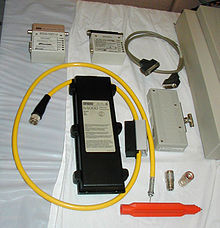
Ethernet was originally based on the idea of computers communicating over a shared coaxial cable acting as a broadcast transmission medium. The method used was similar to those used in radio systems,[e]with the common cable providing the communication channel likened to theLuminiferous aetherin 19th-century physics, and it was from this reference that the name "Ethernet" was derived.[35]
Original Ethernet's shared coaxial cable (the shared medium) traversed a building or campus to every attached machine. A scheme known ascarrier-sense multiple access with collision detection(CSMA/CD) governed the way the computers shared the channel. This scheme was simpler than competing Token Ring orToken Bustechnologies.[f]Computers are connected to anAttachment Unit Interface(AUI)transceiver,which is in turn connected to the cable (withthin Ethernetthe transceiver is usually integrated into the network adapter). While a simple passive wire is highly reliable for small networks, it is not reliable for large extended networks, where damage to the wire in a single place, or a single bad connector, can make the whole Ethernet segment unusable.[g]
Through the first half of the 1980s, Ethernet's10BASE5implementation used a coaxial cable 0.375 inches (9.5 mm) in diameter, later calledthick Ethernetorthicknet.Its successor,10BASE2,calledthin Ethernetorthinnet,used theRG-58coaxial cable. The emphasis was on making installation of the cable easier and less costly.[36]: 57
Since all communication happens on the same wire, any information sent by one computer is received by all, even if that information is intended for just one destination.[h]The network interface card interrupts theCPUonly when applicable packets are received: the card ignores information not addressed to it.[c]Use of a single cable also means that the data bandwidth is shared, such that, for example, available data bandwidth to each device is halved when two stations are simultaneously active.[37]
A collision happens when two stations attempt to transmit at the same time. They corrupt transmitted data and require stations to re-transmit. The lost data and re-transmission reduces throughput. In the worst case, where multiple active hosts connected with maximum allowed cable length attempt to transmit many short frames, excessive collisions can reduce throughput dramatically. However, aXeroxreport in 1980 studied performance of an existing Ethernet installation under both normal and artificially generated heavy load. The report claimed that 98% throughput on the LAN was observed.[38]This is in contrast withtoken passingLANs (Token Ring, Token Bus), all of which suffer throughput degradation as each new node comes into the LAN, due to token waits. This report was controversial, as modeling showed that collision-based networks theoretically became unstable under loads as low as 37% of nominal capacity. Many early researchers failed to understand these results. Performance on real networks is significantly better.[39]
In a modern Ethernet, the stations do not all share one channel through a shared cable or a simplerepeater hub;instead, each station communicates with a switch, which in turn forwards that traffic to the destination station. In this topology, collisions are only possible if station and switch attempt to communicate with each other at the same time, and collisions are limited to this link. Furthermore, the10BASE-Tstandard introduced afull duplexmode of operation which became common withFast Ethernetand the de facto standard withGigabit Ethernet.In full duplex, switch and station can send and receive simultaneously, and therefore modern Ethernets are completely collision-free.
- Comparison between original Ethernet and modern Ethernet
-
The original Ethernet implementation: shared medium, collision-prone. All computers trying to communicate share the same cable, and so compete with each other.
-
Modern Ethernet implementation: switched connection, collision-free. Each computer communicates only with its own switch, without competition for the cable with others.
Repeaters and hubs[edit]
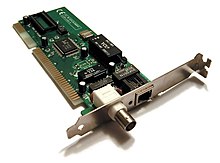
For signal degradation and timing reasons, coaxialEthernet segmentshave a restricted size.[40]Somewhat larger networks can be built by using anEthernet repeater.Early repeaters had only two ports, allowing, at most, a doubling of network size. Once repeaters with more than two ports became available, it was possible to wire the network in astar topology.Early experiments with star topologies (calledFibernet) usingoptical fiberwere published by 1978.[41]
Shared cable Ethernet is always hard to install in offices because its bus topology is in conflict with the star topology cable plans designed into buildings for telephony. Modifying Ethernet to conform to twisted pair telephone wiring already installed in commercial buildings provided another opportunity to lower costs, expand the installed base, and leverage building design, and, thus, twisted-pair Ethernet was the next logical development in the mid-1980s.
Ethernet on unshielded twisted-pair cables (UTP) began withStarLANat 1 Mbit/s in the mid-1980s. In 1987SynOpticsintroduced the first twisted-pair Ethernet at 10 Mbit/s in a star-wired cabling topology with a central hub, later calledLattisNet.[16][35]: 29 [42]These evolved into 10BASE-T, which was designed for point-to-point links only, and all termination was built into the device. This changed repeaters from a specialist device used at the center of large networks to a device that every twisted pair-based network with more than two machines had to use. The tree structure that resulted from this made Ethernet networks easier to maintain by preventing most faults with one peer or its associated cable from affecting other devices on the network.[citation needed]
Despite the physical star topology and the presence of separate transmit and receive channels in the twisted pair and fiber media, repeater-based Ethernet networks still use half-duplex and CSMA/CD, with only minimal activity by the repeater, primarily generation of thejam signalin dealing with packet collisions. Every packet is sent to every other port on the repeater, so bandwidth and security problems are not addressed. The total throughput of the repeater is limited to that of a single link, and all links must operate at the same speed.[35]: 278
Bridging and switching[edit]

While repeaters can isolate some aspects ofEthernet segments,such as cable breakages, they still forward all traffic to all Ethernet devices. The entire network is onecollision domain,and all hosts have to be able to detect collisions anywhere on the network. This limits the number of repeaters between the farthest nodes and creates practical limits on how many machines can communicate on an Ethernet network. Segments joined by repeaters have to all operate at the same speed, making phased-in upgrades impossible.[citation needed]
To alleviate these problems, bridging was created to communicate at the data link layer while isolating the physical layer. With bridging, only well-formed Ethernet packets are forwarded from one Ethernet segment to another; collisions and packet errors are isolated. At initial startup, Ethernet bridges work somewhat like Ethernet repeaters, passing all traffic between segments. By observing the source addresses of incoming frames, the bridge then builds an address table associating addresses to segments. Once an address is learned, the bridge forwards network traffic destined for that address only to the associated segment, improving overall performance.Broadcasttraffic is still forwarded to all network segments. Bridges also overcome the limits on total segments between two hosts and allow the mi xing of speeds, both of which are critical to the incremental deployment of faster Ethernet variants.[citation needed]
In 1989,Motorola Codexintroduced their 6310 EtherSpan, andKalpanaintroduced their EtherSwitch; these were examples of the first commercial Ethernet switches.[i]Early switches such as this usedcut-through switchingwhere only the header of the incoming packet is examined before it is either dropped or forwarded to another segment.[43]This reduces the forwarding latency. One drawback of this method is that it does not readily allow a mixture of different link speeds. Another is that packets that have been corrupted are still propagated through the network. The eventual remedy for this was a return to the originalstore and forwardapproach of bridging, where the packet is read into a buffer on the switch in its entirety, itsframe check sequenceverified and only then the packet is forwarded.[43]In modern network equipment, this process is typically done usingapplication-specific integrated circuitsallowing packets to be forwarded atwire speed.[citation needed]
When a twisted pair or fiber link segment is used and neither end is connected to a repeater,full-duplexEthernet becomes possible over that segment. In full-duplex mode, both devices can transmit and receive to and from each other at the same time, and there is no collision domain.[44]This doubles the aggregate bandwidth of the link and is sometimes advertised as double the link speed (for example, 200 Mbit/s for Fast Ethernet).[j]The elimination of the collision domain for these connections also means that all the link's bandwidth can be used by the two devices on that segment and that segment length is not limited by the constraints of collision detection.
Since packets are typically delivered only to the port they are intended for, traffic on a switched Ethernet is less public than on shared-medium Ethernet.Despite this, switched Ethernet should still be regarded as an insecure network technology, because it is easy to subvert switched Ethernet systems by means such asARP spoofingandMAC flooding.[citation needed][45]
The bandwidth advantages, the improved isolation of devices from each other, the ability to easily mix different speeds of devices and the elimination of the chaining limits inherent in non-switched Ethernet have made switched Ethernet the dominant network technology.[46]
Advanced networking[edit]

Simple switched Ethernet networks, while a great improvement over repeater-based Ethernet, suffer from single points of failure, attacks that trick switches or hosts into sending data to a machine even if it is not intended for it, scalability and security issues with regard toswitching loops,broadcast radiation,andmulticasttraffic.[citation needed]
Advanced networking features in switches useShortest Path Bridging(SPB) or theSpanning Tree Protocol(STP) to maintain a loop-free, meshed network, allowing physical loops for redundancy (STP) or load-balancing (SPB). Shortest Path Bridging includes the use of thelink-state routing protocolIS-ISto allow larger networks with shortest path routes between devices.
Advanced networking features also ensure port security, provide protection features such as MAC lockdown[47]and broadcast radiation filtering, useVLANsto keep different classes of users separate while using the same physical infrastructure, employmultilayer switchingto route between different classes, and uselink aggregationto add bandwidth to overloaded links and to provide some redundancy.[citation needed]
In 2016, Ethernet replacedInfiniBandas the most popular system interconnect ofTOP500supercomputers.[48]
Varieties[edit]
The Ethernet physical layer evolved over a considerable time span and encompasses coaxial, twisted pair and fiber-optic physical media interfaces, with speeds from1 Mbit/sto400 Gbit/s.[49]The first introduction of twisted-pair CSMA/CD wasStarLAN,standardized as 802.3 1BASE5.[50]While 1BASE5 had little market penetration, it defined the physical apparatus (wire, plug/jack, pin-out, and wiring plan) that would be carried over to 10BASE-T through 10GBASE-T.
The most common forms used are10BASE-T, 100BASE-TX, and 1000BASE-T.All three use twisted-pair cables and8P8C modular connectors.They run at10 Mbit/s,100 Mbit/s,and1 Gbit/s,respectively.[51][52][53]
Fiber opticvariants of Ethernet (that commonly useSFP modules) are also very popular in larger networks, offering high performance, better electrical isolation and longer distance (tens of kilometers with some versions). In general, networkprotocol stacksoftware will work similarly on all varieties.[54]
Frame structure[edit]

In IEEE 802.3, adatagramis called apacketorframe.Packetis used to describe the overall transmission unit and includes thepreamble,start frame delimiter(SFD) and carrier extension (if present).[k]Theframebegins after the start frame delimiter with a frame header featuring source and destination MAC addresses and the EtherType field giving either the protocol type for the payload protocol or the length of the payload. The middle section of the frame consists of payload data including any headers for other protocols (for example, Internet Protocol) carried in the frame. The frame ends with a 32-bitcyclic redundancy check,which is used to detect corruption ofdata in transit.[55]: sections 3.1.1 and 3.2 Notably, Ethernet packets have notime-to-live field,leading to possible problems in the presence of a switching loop.
Autonegotiation[edit]
Autonegotiation is the procedure by which two connected devices choose common transmission parameters, e.g. speed and duplex mode. Autonegotiation was initially an optional feature, first introduced with 100BASE-TX (1995 IEEE 802.3u Fast Ethernet standard), and is backward compatible with 10BASE-T. The specification was improved in the 1998 release of IEEE 802.3. Autonegotiation is mandatory for 1000BASE-T and faster.
Error conditions[edit]
Switching loop[edit]
A switching loop or bridge loop occurs incomputer networkswhen there is more than oneLayer 2(OSI model) path between two endpoints (e.g. multiple connections between twonetwork switchesor two ports on the same switch connected to each other). The loop createsbroadcast stormsas broadcasts andmulticastsare forwarded by switches out everyport,the switch or switches will repeatedly rebroadcast the broadcast messages flooding the network. Since the Layer 2 header does not support atime to live(TTL) value, if a frame is sent into a looped topology, it can loop forever.[56]
A physical topology that contains switching or bridge loops is attractive for redundancy reasons, yet a switched network must not have loops. The solution is to allow physical loops, but create a loop-free logical topology using the SPB protocol or the older STP on the network switches.[citation needed]
Jabber[edit]
A node that is sending longer than the maximum transmission window for an Ethernet packet is considered to bejabbering.Depending on the physical topology, jabber detection and remedy differ somewhat.
- AnMAUis required to detect and stop abnormally long transmission from theDTE(longer than 20–150 ms) in order to prevent permanent network disruption.[57]
- On an electrically shared medium (10BASE5, 10BASE2, 1BASE5), jabber can only be detected by each end node, stopping reception. No further remedy is possible.[58]
- A repeater/repeater hub uses a jabber timer that ends retransmission to the other ports when it expires. The timer runs for 25,000 to 50,000 bit times for 1 Mbit/s,[59]40,000 to 75,000 bit times for 10 and 100 Mbit/s,[60][61]and 80,000 to 150,000 bit times for 1 Gbit/s.[62]Jabbering ports are partitioned off the network until a carrier is no longer detected.[63]
- End nodes utilizing a MAC layer will usually detect an oversized Ethernet frame and cease receiving. A bridge/switch will not forward the frame.[64]
- A non-uniform frame size configuration in the network usingjumbo framesmay be detected as jabber by end nodes.[citation needed]Jumbo frames are not part of the officialIEEE 802.3Ethernet standard.
- A packet detected as jabber by an upstream repeater and subsequently cut off has an invalidframe check sequenceand is dropped.[65]
Runt frames[edit]
- Runtsare packets or frames smaller than the minimum allowed size. They are dropped and not propagated.[66]
See also[edit]
Notes[edit]
- ^The experimental Ethernet described in the 1976 paper ran at 2.94 Mbit/s and has eight-bit destination and source address fields, so the original Ethernet addresses are not theMAC addressesthey are today.[13]By software convention, the 16 bits after the destination and source address fields specify a "packet type", but, as the paper says, "different protocols use disjoint sets of packet types". Thus the original packet types could vary within each different protocol. This is in contrast to theEtherTypein the IEEE Ethernet standard, which specifies the protocol being used.
- ^In some cases, the factory-assigned address can be overridden, either to avoid an address change when an adapter is replaced or to uselocally administered addresses.
- ^abUnless it is put intopromiscuous mode.
- ^Of course bridges and switches will accept other addresses for forwarding the packet.
- ^There are fundamental differences between wireless and wired shared-medium communication, such as the fact that it is much easier to detect collisions in a wired system than a wireless system.
- ^In a CSMA/CD system packets must be large enough to guarantee that the leading edge of the propagating wave of a message gets to all parts of the medium and back again before the transmitter stops transmitting, guaranteeing thatcollisions(two or more packets initiated within a window of time that forced them to overlap) are discovered. As a result, the minimum packet size and the physical medium's total length are closely linked.
- ^Multipoint systems are also prone to strange failure modes when an electrical discontinuity reflects the signal in such a manner that some nodes would work properly, while others work slowly because of excessive retries or not at all. Seestanding wavefor an explanation. These could be much more difficult to diagnose than a complete failure of the segment.
- ^Thisone speaks, all listenproperty is a security weakness of shared-medium Ethernet, since a node on an Ethernet network can eavesdrop on all traffic on the wire if it so chooses.
- ^The termswitchwas invented by device manufacturers and does not appear in the IEEE 802.3 standard.
- ^This is misleading, as performance will double only if traffic patterns are symmetrical.
- ^The carrier extension is defined to assist collision detection on shared-media gigabit Ethernet.
References[edit]
- ^Ralph Santitoro (2003)."Metro Ethernet Services – A Technical Overview"(PDF).mef.net.Archived fromthe original(PDF)on December 22, 2018.RetrievedJanuary 9,2016.
- ^Xerox (August 1976)."Alto: A Personal Computer System Hardware Manual"(PDF).Xerox. p. 37.Archived(PDF)from the original on September 4, 2017.RetrievedAugust 25,2015.
- ^Charles M. Kozierok (September 20, 2005)."Data Link Layer (Layer 2)".tcpipguide.Archivedfrom the original on May 20, 2019.RetrievedJanuary 9,2016.
- ^abcdeThe History of Ethernet.NetEvents.tv. 2006.Archivedfrom the original on December 11, 2021.RetrievedSeptember 10,2011.
- ^"Ethernet Prototype Circuit Board".Smithsonian National Museum of American History. 1973.Archivedfrom the original on October 28, 2014.RetrievedSeptember 2,2007.
- ^abJoanna Goodrich (November 16, 2023)."Ethernet is Still Going Strong After 50 Years".IEEE Spectrum.
- ^Gerald W. Brock (September 25, 2003).The Second Information Revolution.Harvard University Press. p.151.ISBN0-674-01178-3.
- ^Metz, Cade (March 22, 2023)."Turing Award Won by Co-Inventor of Ethernet Technology".The New York Times.Archivedfrom the original on March 23, 2023.RetrievedMarch 23,2023.
- ^Cade Metz (March 13, 2009)."Ethernet – a
networking protocolname for the ages: Michelson, Morley, and Metcalfe ".The Register.p. 2.Archivedfrom the original on November 8, 2012.RetrievedMarch 4,2013. - ^Mary Bellis."Inventors of the Modern Computer".About. Archived fromthe originalon July 11, 2012.RetrievedSeptember 10,2011.
- ^U.S. patent 4,063,220"Multipoint data communication system (with collision detection)"
- ^Robert Metcalfe;David Boggs(July 1976)."Ethernet: Distributed Packet Switching for Local Computer Networks"(PDF).Communications of the ACM.19(7): 395–405.doi:10.1145/360248.360253.S2CID429216.Archived(PDF)from the original on March 15, 2016.RetrievedAugust 25,2015.
- ^John F. Shoch;Yogen K. Dalal; David D. Redell;Ronald C. Crane(August 1982)."Evolution of the Ethernet Local Computer Network"(PDF).IEEE Computer.15(8): 14–26.doi:10.1109/MC.1982.1654107.S2CID14546631.Archived(PDF)from the original on August 15, 2011.RetrievedApril 7,2011.
- ^Pelkey, James L. (2007). "Yogen Dalal".Entrepreneurial Capitalism and Innovation: A History of Computer Communications, 1968–1988.Archivedfrom the original on September 5, 2019.RetrievedSeptember 5,2019.
- ^"Introduction to Ethernet Technologies".wband.WideBand Products.Archivedfrom the original on April 10, 2018.RetrievedApril 9,2018.
- ^abcdefvon Burg, Urs; Kenney, Martin (December 2003)."Sponsors, Communities, and Standards: Ethernet vs. Token Ring in the Local Area Networking Business"(PDF).Industry & Innovation.10(4): 351–375.doi:10.1080/1366271032000163621.S2CID153804163.Archived fromthe original(PDF)on December 6, 2011.RetrievedFebruary 17,2014.
- ^Charles E. Spurgeon (2000)."Chapter 1. The Evolution of Ethernet".Ethernet: The Definitive Guide.ISBN1565926609.Archivedfrom the original on December 5, 2018.RetrievedDecember 4,2018.
- ^"Ethernet: Bridging the communications gap".Hardcopy.March 1981. p. 12.
- ^abDigital Equipment Corporation; Intel Corporation; Xerox Corporation (September 30, 1980)."The Ethernet, A Local Area Network. Data Link Layer and Physical Layer Specifications, Version 1.0"(PDF).Xerox Corporation.Archived(PDF)from the original on August 25, 2019.RetrievedDecember 10,2011.
{{cite journal}}:Cite journal requires|journal=(help) - ^Digital Equipment Corporation; Intel Corporation; Xerox Corporation (November 1982)."The Ethernet, A Local Area Network. Data Link Layer and Physical Layer Specifications, Version 2.0"(PDF).Xerox Corporation.Archived(PDF)from the original on December 15, 2011.RetrievedDecember 10,2011.
{{cite journal}}:Cite journal requires|journal=(help) - ^"IEEE 802.3 'Standard for Ethernet' Marks 30 Years of Innovation and Global Market Growth"(Press release). IEEE. June 24, 2013. Archived fromthe originalon January 12, 2014.RetrievedJanuary 11,2014.
- ^abRobert Breyer; Sean Riley (1999).Switched, Fast, and Gigabit Ethernet.Macmillan.ISBN1-57870-073-6.
- ^Jamie Parker Pearson (1992).Digital at Work.Digital Press. p. 163.ISBN1-55558-092-0.
- ^Rick Merritt (December 20, 2010)."Shifts, growth ahead for 10G Ethernet".E Times.Archivedfrom the original on January 18, 2012.RetrievedSeptember 10,2011.
{{cite journal}}:Cite journal requires|journal=(help) - ^"My oh My – Ethernet Growth Continues to Soar; Surpasses Legacy".Telecom News Now. July 29, 2011. Archived fromthe originalon November 18, 2011.RetrievedSeptember 10,2011.
- ^Jim Duffy (February 22, 2010)."Cisco, Juniper, HP drive Ethernet switch market in Q4".Network World.International Data Group.Archivedfrom the original on August 11, 2019.RetrievedAugust 11,2019.
- ^Vic Hayes (August 27, 2001)."Letter to FCC"(PDF).Archived fromthe original(PDF)on July 27, 2011.RetrievedOctober 22,2010.
IEEE 802 has the basic charter to develop and maintain networking standards... IEEE 802 was formed in February 1980...
- ^IEEE 802.3-2008, p.iv
- ^"ISO 8802-3:1989".ISO.Archivedfrom the original on July 9, 2015.RetrievedJuly 8,2015.
- ^Jim Duffy (April 20, 2009)."Evolution of Ethernet".Network World.Archived fromthe originalon June 11, 2017.RetrievedJanuary 1,2016.
- ^Douglas E. Comer(2000).Internetworking with TCP/IP – Principles, Protocols and Architecture(4th ed.). Prentice Hall.ISBN0-13-018380-6.2.4.9 – Ethernet Hardware Addresses, p. 29, explains the filtering.
- ^Iljitsch van Beijnum (July 15, 2011)."Speed matters: how Ethernet went from 3Mbps to 100Gbps... and beyond".Ars Technica.Archivedfrom the original on July 9, 2012.RetrievedJuly 15,2011.
All aspects of Ethernet were changed: its MAC procedure, the bit encoding, the wiring... only the packet format has remained the same.
- ^Fast Ethernet Turtorial,Lantronix, December 9, 2014,archivedfrom the original on November 28, 2015,retrievedJanuary 1,2016
- ^Geetaj Channana (November 1, 2004)."Motherboard Chipsets Roundup".PCQuest. Archived fromthe originalon July 8, 2011.RetrievedOctober 22,2010.
While comparing motherboards in the last issue we found that all motherboards support Ethernet connection on board.
- ^abcCharles E. Spurgeon (2000).Ethernet: The Definitive Guide.O'Reilly.ISBN978-1-56592-660-8.
- ^Heinz-Gerd Hegering; Alfred Lapple (1993).Ethernet: Building a Communications Infrastructure.Addison-Wesley.ISBN0-201-62405-2.
- ^Ethernet Tutorial – Part I: Networking Basics,Lantronix, December 9, 2014,archivedfrom the original on February 13, 2016,retrievedJanuary 1,2016
- ^Shoch, John F.; Hupp, Jon A. (December 1980)."Measured performance of an Ethernet local network".Communications of the ACM.23(12). ACM Press: 711–721.doi:10.1145/359038.359044.ISSN0001-0782.S2CID1002624.
- ^Boggs, D.R.; Mogul, J.C. & Kent, C.A. (September 1988)."Measured capacity of an Ethernet: myths and reality"(PDF).DEC WRL.Archived(PDF)from the original on March 2, 2012.RetrievedDecember 20,2012.
{{cite journal}}:Cite journal requires|journal=(help) - ^"Ethernet Media Standards and Distances".kb.wisc.edu.Archivedfrom the original on June 19, 2010.RetrievedOctober 10,2017.
- ^Eric G. Rawson; Robert M. Metcalfe (July 1978)."Fibemet: Multimode Optical Fibers for Local Computer Networks"(PDF).IEEE Transactions on Communications.26(7): 983–990.doi:10.1109/TCOM.1978.1094189.Archived(PDF)from the original on August 15, 2011.RetrievedJune 11,2011.
- ^Urs von Burg (2001).The Triumph of Ethernet: technological communities and the battle for the LAN standard.Stanford University Press. p. 175.ISBN0-8047-4094-1.Archivedfrom the original on January 9, 2017.RetrievedSeptember 23,2016.
- ^abRobert J. Kohlhepp (October 2, 2000)."The 10 Most Important Products of the Decade".Network Computing. Archived fromthe originalon January 5, 2010.RetrievedFebruary 25,2008.
- ^Nick Pidgeon (April 2000)."Full-duplex Ethernet".How Stuff Works.Archivedfrom the original on June 4, 2020.RetrievedFebruary 3,2020.
- ^Wang, Shuangbao Paul; Ledley, Robert S. (October 25, 2012).Computer Architecture and Security: Fundamentals of Designing Secure Computer Systems.John Wiley & Sons.ISBN978-1-118-16883-7.Archivedfrom the original on March 15, 2021.RetrievedOctober 2,2020.
- ^"Token Ring-to-Ethernet Migration".Cisco.Archivedfrom the original on July 8, 2011.RetrievedOctober 22,2010.
Respondents were first asked about their current and planned desktop LAN attachment standards. The results were clear—switched Fast Ethernet is the dominant choice for desktop connectivity to the network
- ^David Davis (October 11, 2007)."Lock down Cisco switch port security".Archivedfrom the original on July 31, 2020.RetrievedApril 19,2020.
- ^"HIGHLIGHTS – JUNE 2016".June 2016.Archivedfrom the original on January 30, 2021.RetrievedFebruary 19,2021.
InfiniBand technology is now found on 205 systems, down from 235 systems, and is now the second most-used internal system interconnect technology. Gigabit Ethernet has risen to 218 systems up from 182 systems, in large part thanks to 176 systems now using 10G interfaces.
- ^"[STDS-802-3-400G] IEEE P802.3bs Approved!".IEEE 802.3bs Task Force.Archivedfrom the original on June 12, 2018.RetrievedDecember 14,2017.
- ^"1BASE5 Medium Specification (StarLAN)".cs.nthu.edu.tw.December 28, 1996.Archivedfrom the original on July 10, 2015.RetrievedNovember 11,2014.
- ^IEEE 802.314. Twisted-pair medium attachment unit (MAU) and baseband medium, type 10BASE-T including type 10BASE-Te
- ^IEEE 802.325. Physical Medium Dependent (PMD) sublayer and baseband medium, type 100BASE-TX
- ^IEEE 802.340. Physical Coding Sublayer (PCS), Physical Medium Attachment (PMA) sublayer and baseband medium, type 1000BASE-T
- ^IEEE 802.34.3 Interfaces to/from adjacent layers
- ^"802.3-2012 – IEEE Standard for Ethernet"(PDF).ieee.org.IEEE Standards Association. December 28, 2012.Archivedfrom the original on February 23, 2014.RetrievedFebruary 8,2014.
- ^"Layer 2 Switching Loops in Network Explained".ComputerNetworkingNotes.Archivedfrom the original on January 8, 2022.RetrievedJanuary 8,2022.
- ^IEEE 802.38.2 MAU functional specifications
- ^IEEE 802.38.2.1.5 Jabber function requirements
- ^IEEE 802.312.4.3.2.3 Jabber function
- ^IEEE 802.39.6.5 MAU Jabber Lockup Protection
- ^IEEE 802.327.3.2.1.4 Timers
- ^IEEE 802.341.2.2.1.4 Timers
- ^IEEE 802.327.3.1.7 Receive jabber functional requirements
- ^IEEE 802.1Table C-1—Largest frame base values
- ^"3.1.1 Packet format",802.3-2012 - IEEE Standard for Ethernet(PDF),IEEE Standards Association,December 28, 2012,retrievedJuly 5,2015
- ^"Troubleshooting Ethernet".Cisco.Archivedfrom the original on March 3, 2021.RetrievedMay 18,2021.
Further reading[edit]
- Digital Equipment Corporation; Intel Corporation; Xerox Corporation (September 1980)."The Ethernet: A Local Area Network".ACM SIGCOMM Computer Communication Review.11(3): 20.doi:10.1145/1015591.1015594.S2CID31441899.Version 1.0 of the DIX specification.
- "Ethernet Technologies".Internetworking Technology Handbook.Cisco Systems. Archived fromthe originalon December 28, 2018.RetrievedApril 11,2011.
- Charles E. Spurgeon (2000).Ethernet: The Definitive Guide.O'Reilly Media.ISBN978-1565-9266-08.
- Yogen Dalal."Ethernet History".blog.

